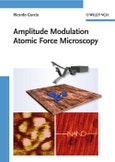Table of Contents
Preface XI
Annotation List XIII
1 Introduction 1
1.1 Historical Perspective 1
1.2 Evolution Periods and Milestones 2
1.2.1 Early Times (1987–1992) 2
1.2.2 Exploration and Expansion (1993–1999) 3
1.2.3 Cantilever–Tip Dynamics (2000–2006) 4
1.2.4 Multifrequency AFM (2007 to Present) 4
1.3 Tapping Mode or Amplitude Modulation Force Microscopy? 5
1.4 Other Dynamic AFM Methods 6
1.4.1 Frequency Modulation AFM 6
1.4.2 Amplitude Modulation versus Frequency Modulation AFM 6
2 Instrumental and Conceptual Aspects 9
2.1 Introduction 9
2.2 Amplitude Modulation AFM 9
2.3 Elements of an Amplitude Modulation AFM 10
2.3.1 Feedback Controller 10
2.3.2 Optical Beam Deflection 12
2.3.3 Other Detection Methods 13
2.3.4 Tip–Sample Motion System 14
2.3.5 Imaging Acquisition and Display 14
2.4 Cantilever–Tip System 15
2.4.1 Cantilevers 16
2.4.2 Tips 17
2.4.3 Excitation of Cantilever–Tip Oscillations 18
2.5 Calibration Protocols 19
2.5.1 Optical Sensitivity 19
2.5.2 Calibration of the Cantilever Force Constant 20
2.5.2.1 Thermal Noise Method 20
2.5.2.2 Sader Method 21
2.6 Common Experimental Curves 21
2.6.1 Resonance Curves in Air and Liquids 21
2.6.2 Amplitude and Phase Shift Distance Curves 23
2.7 Displacements and Distances 23
3 Tip–Surface Interaction Forces 25
3.1 Introduction 25
3.2 Van der Waals Forces 25
3.3 Contact Mechanics Forces 27
3.3.1 Derjaguin–Muller–Toporov Model 29
3.3.2 Johnson–Kendall–Roberts Model 30
3.4 Capillary Force 30
3.5 Forces in Liquid 32
3.5.1 Electrostatic Double-Layer Force 32
3.5.2 Derjaguin–Landau–Verwey–Overbeek Forces 33
3.5.3 Solvation Forces 34
3.5.4 Other Forces in Aqueous Solutions 35
3.6 Electrostatic Forces 35
3.7 Nonconservative Forces 36
3.8 Net Tip–Surface Force 38
3.8.1 Tip–Surface Force for a Stiff Material with Surface Adhesion Hysteresis 38
3.8.2 Tip–Surface Force for a Viscoelastic Material 39
4 Theory of Amplitude Modulation AFM 41
4.1 Introduction 41
4.2 Equation of Motion 42
4.3 The Point-Mass Model: Elemental Aspects 43
4.3.1 The Harmonic Oscillator 44
4.3.2 Dynamics of a Weakly Perturbed Harmonic Oscillator 46
4.4 The Point-Mass Model: Analytical Approximations 48
4.4.1 Perturbed Harmonic Oscillator 49
4.4.2 Wang Model 50
4.4.3 Virial Dissipation Method 51
4.5 Peak and Average Forces 52
4.5.1 Peak Forces 53
4.5.2 Average Forces 53
4.6 The Point-Mass Model: Numerical Solutions 54
4.6.1 Attractive and Repulsive Interaction Regimes 55
4.6.2 Driving the Cantilever Below Resonance 56
4.7 The Effective Model 56
Appendix: The Runge–Kutta Algorithm 56
5 Advanced Theory of Amplitude Modulation AFM 59
5.1 Introduction 59
5.2 Q-Control 59
5.3 Nonlinear Dynamics 62
5.4 Continuous Cantilever Beam Model 64
5.4.1 One-Dimensional Model 64
5.5 Equivalence between Point-Mass and Continuous Models 67
5.6 Systems Theory Description 69
5.7 Force Reconstruction Methods: Force versus Distance 70
5.7.1 Lee–Jhe Method 70
5.7.2 Hölscher Method 71
5.8 Time-Resolved Force 73
5.8.1 Acceleration 74
5.8.2 Higher Harmonics Method 74
5.8.3 Direct Time-Resolved Force Measurements 76
6 Amplitude Modulation AFM in Liquid 77
6.1 Introduction 77
6.2 Qualitative Aspects of the Cantilever Dynamics in Liquid 77
6.2.1 Dynamics Far from the Surface 77
6.2.2 Dynamics Close to the Surface 78
6.3 Interaction Forces in Liquid 80
6.4 Some Experimental and Conceptual Considerations 82
6.5 Theoretical Descriptions of Dynamic AFM in Liquid 84
6.5.1 Analytical Descriptions: Far from the Surface 84
6.5.2 Analytical and Numerical Descriptions in the Presence of Tip–Surface Forces 87
6.5.3 Semianalytical Models 87
6.5.4 Finite Element Simulations 89
7 Phase Imaging Atomic Force Microscopy 91
7.1 Introduction 91
7.2 Phase Imaging Atomic Force Microscopy 91
7.3 Theory of Phase Imaging AFM 95
7.3.1 Phase Imaging Atomic AFM: HighQ 95
7.3.2 Phase Imaging AFM: LowQ 97
7.4 Energy Dissipation Measurements at the Nanoscale 98
7.4.1 Energy Dissipation and Observables 98
7.4.2 Identification of Energy Dissipation Processes 99
7.4.3 Atomic and Nanoscale Dissipation Processes 100
8 Resolution, Noise, and Sensitivity 103
8.1 Introduction 103
8.2 Spatial Resolution 103
8.2.1 Vertical Resolution and Noise 104
8.2.2 Lateral Resolution 106
8.3 Image Distortion and Surface Reconstruction 108
8.4 Force-Induced Surface Deformations 109
8.5 Atomic, Molecular, and Subnanometer Lateral Resolution 111
8.5.1 True Resolution 112
8.6 High-Resolution Imaging of Isolated Molecules 113
8.7 Conditions for High-Resolution Imaging 113
8.8 Image Artifacts 114
9 Multifrequency Atomic Force Microscopy 117
9.1 Introduction 117
9.2 Normal Modes and Harmonics 117
9.2.1 Generation of Higher Harmonics 117
9.2.2 Coupling Eigenmodes and Harmonics 120
9.2.3 Imaging Beyond the Fundamental Mode 121
9.3 Bimodal AFM 122
9.3.1 Intermodulation Frequencies 124
9.4 Mode-Synthesizing Atomic Force Microscopy 125
9.5 Torsional Harmonic AFM 126
9.6 Band Excitation 127
10 Beyond Topographic Imaging 129
10.1 Introduction 129
10.2 Scattering Near-Field Optical Microscopy 129
10.3 Topography and Recognition Imaging 132
10.3.1 Tip Functionalization 133
10.4 Nanofabrication by AFM 134
10.4.1 AFM Oxidation Nanolithography 134
10.4.2 Patterning and Devices 136
References 139
Index 175








